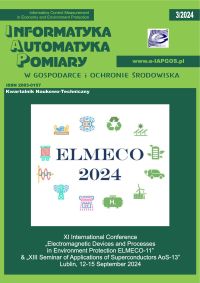ZASTOSOWANIE SIECI PETRIEGO W SYSTEMACH WSPOMAGANIA DECYZJI OPARTYCH NA INTELIGENTNEJ WIELOŹRÓDŁOWEJ ANALIZIE DANYCH
Tomasz Rymarczyk
tomasz.rymarczyk@netrix.com.plResearch and Development Center, Netrix S.A., Lublin; University of Economics and Innovation in Lublin (Polska)
Grzegorz Kłosowski
Lublin University of Technology, Faculty of Management, Department of Organization of Enterprise (Polska)
Tomasz Cieplak
Lublin University of Technology, Faculty of Management, Department of Organization of Enterprise (Polska)
Abstrakt
Artykuł dotyczy problematyki projektowania zautomatyzowanych systemów analizy danych biznesowych. Opracowano ogólny model systemu wspomagania decyzji, w którym jeden z modułów funkcjonuje w oparciu o sieci Petriego. Zaprezentowano sposób implementacji sieci Petriego do realizacji zadań optymalizacyjnych dotyczących zorientowanego na usługi systemu wspomagania decyzji. Przeprowadzono szereg eksperymentów symulacyjnych wykorzystując model przepływu pracy utworzony na bazie sieci Petriego. Rezultatem badań było wyłonienie optymalnego zbioru parametrów procesu biznesowego.
Słowa kluczowe:
sieci Petriego, systemy wspomagania decyzji, analiza danych, przetwarzanie danych biznesowychBibliografia
Balbis L., Ordys A., Grimble M., Pang Y.: Tutorial introduction to the modellingand control of hybrid systems. Int J Modell Ident Control. 2(4)/2007, 259–272.
Google Scholar
Ben-Arieh D., Kumar R.R., Tiwari M.K.: Analysis of assembly operations’ difficulty using enhanced expert highlevel colored fuzzy Petri net modelm. Robotics and Computer-integrated Manufacturing 20(5)/2004, 385–403.
Google Scholar
Dong M., Chen F.F.: Process modelling and analysis of manufacturing supply chain networks using object-oriented Petri nets. Robotics and Computer-Integrated Manufacturing 17(1–2)/2001, 121–129.
Google Scholar
Heemels W., De Schutter B., Bemporad A.: Equivalence of hybrid dynamical models. Automatica 37(7)/2001, 1085–1091.
Google Scholar
Jiang Z. et al.: Colored Petri nets with changeable structures (CPN-CS) and their applications in modelling one-of-a-kind production (OKP) systems. Computers & Industrial Engineering 41(3)/2001, 279–308.
Google Scholar
Kłosowski G., Gola A., Świć A.: Human Resource Selection for Manufacturing System Using Petri Nets. Applied Mechanics and Materials 791/2015, 132–140.
Google Scholar
Kuma S. et al.: Expert enhanced coloured stochastic Petri net and its application in assembly/disassembly. International Journal of Production Research 41(12)/2003, 2727–2762.
Google Scholar
Lee J., Korbaa O.: Modeling and scheduling of ratio-driven FMS using unfolding time Petri nets. Computers & Industrial Engineering 46(4)/2004, 639–653.
Google Scholar
Tüysüz F., Kahraman C.: Modelling a flexible manufacturing cell using stochastic Petri nets with fuzzy parameters. Expert Systems with Applications 37(5)/2010, 3910–3920.
Google Scholar
Vatani M., Doustmohammadi A.: Decomposition of first-order hybrid Petri nets for hierarchical control of manufacturing systems. Journal of Manufacturing Systems 35/2015, 206–214.
Google Scholar
Villani E., Miyagi P.E., Valette R.: Modelling and analysis of hybrid supervisorysystems – a Petri net approach. Springer-Verlag, London 2007.
Google Scholar
Wu N., Chu F., Chu C., Zhou M.: Hybrid Petri net modeling and schedulability analysis of high fusion point oil transportation under tank grouping strategy for crudeoil operations in refinery. IEEE Trans. Syst. Man. Cybern. 40(2)/2010, 159–75.
Google Scholar
Autorzy
Tomasz Rymarczyktomasz.rymarczyk@netrix.com.pl
Research and Development Center, Netrix S.A., Lublin; University of Economics and Innovation in Lublin Polska
Autorzy
Grzegorz KłosowskiLublin University of Technology, Faculty of Management, Department of Organization of Enterprise Polska
Autorzy
Tomasz CieplakLublin University of Technology, Faculty of Management, Department of Organization of Enterprise Polska
Statystyki
Abstract views: 244PDF downloads: 62
Licencja

Utwór dostępny jest na licencji Creative Commons Uznanie autorstwa – Na tych samych warunkach 4.0 Miedzynarodowe.
Inne teksty tego samego autora
- Tomasz Rymarczyk, Przemysław Adamkiewicz, TOMOGRAFIA IMPEDANCYJNA DO WYZNACZANIA WILGOTNOŚCI W MODELU WAŁU , Informatyka, Automatyka, Pomiary w Gospodarce i Ochronie Środowiska: Tom 7 Nr 1 (2017)
- Tomasz Rymarczyk, Paweł Tchórzewski, Jan Sikora, WYKRYWANIE SZCZELIN POWIETRZNYCH W CHODNIKU KOPALNI MIEDZI ZA POMOCĄ ELEKTRYCZNEJ TOMOGRAFII IMPEDANCYJNEJ , Informatyka, Automatyka, Pomiary w Gospodarce i Ochronie Środowiska: Tom 7 Nr 1 (2017)
- Konrad Kania, Tomasz Rymarczyk, METODY DO ANALIZY DETEKCYJNEJ W SYSTEMIE KONTROLI JAKOŚCI , Informatyka, Automatyka, Pomiary w Gospodarce i Ochronie Środowiska: Tom 8 Nr 3 (2018)
- Tomasz Rymarczyk, ZBIORY POZIOMICOWE I ALGORYTMY INTELIGENCJI OBLICZENIOWEJ DO ANALIZY OBRAZÓW MEDYCZNYCH W SYSTEMIE E-MEDICUS , Informatyka, Automatyka, Pomiary w Gospodarce i Ochronie Środowiska: Tom 7 Nr 1 (2017)
- Tomasz Rymarczyk, Jan Sikora, ROZPRASZANIE PRZEZ PUSTE PRZESTRZENIE KOŁOWE ZE SZTYWNĄ GRANICĄ: PROSTE I ODWROTNE ZAGADNIENIA DLA OBSZARÓW OTWARTYCH I ZAMKNIĘTYCH , Informatyka, Automatyka, Pomiary w Gospodarce i Ochronie Środowiska: Tom 12 Nr 4 (2022)








